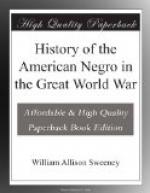Shot heard around the world—Crispus ATTTUCKS—slave leads sons of freedom—the Boston Massacre—anniversary kept for years—William Nell, historian—3,000 negroes in Washington’s forces—A stirring history—negro woman soldier—border Indian wars—negro heroes
Our American school histories teach us that the “shot which was heard around the world",—the opening gun of the Revolutionary war, was fired at Lexington in 1775. The phrase embodies a precious sentiment; time has molded many leaders, the inspiration for almost a century and a half of the patriotic youth of our land. This is as it should be. All honor and all praise to the deathless heroes of that time and occasion.
But why has not history been more just; at least, more explicit? Why not say that the shot which started the Revolution—that first great movement for human liberty and the emancipation of nations—was fired five years earlier; was fired not by, but at, a Negro, Crispus Attucks? The leader of the citizens in that event of March 5, 1770, known as the Boston Massacre, he was the first man upon whom the British soldiers fired and the first to fall; the pioneer martyr for American independence.
It is perhaps fitting; a manifestation of the inscrutable ways of Providence, that the first life given in behalf of a nation about to throw off a yoke of bondage, was that of a representative of a race; despised, oppressed and enslaved.
Botta the historian, in speaking of the scenes of the 5th of March says:
“The people were greatly exasperated. The multitude ran towards King street, crying, ’Let us drive out these ribalds; they have no business here.’ The rioters rushed furiously towards the Custom House; they approached the sentinel, crying ‘Kill him, kill him!’ They assaulted him with snowballs, pieces of ice, and whatever they could lay their hands upon.
“The guard were then called, and in marching to the Custom House, they encountered a band of the populace, led by a mulatto named Attucks, who brandished their clubs and pelted them with snowballs. The maledictions, the imprecations, the execrations of the multitude, were horrible. In the midst of a torrent of invective from every quarter, the military were challenged to fire. The populace advanced to the points of their bayonets.
“The soldiers appeared like statues; the cries, the howlings, the menaces, the violent din of bells still sounding the alarm, increased the confusion and the horrors of these moments; at length the mulatto Attucks and twelve of his companions, pressing forward, environed the soldiers and striking their muskets with their clubs, cried to the multitude: ’Be not afraid, they dare




